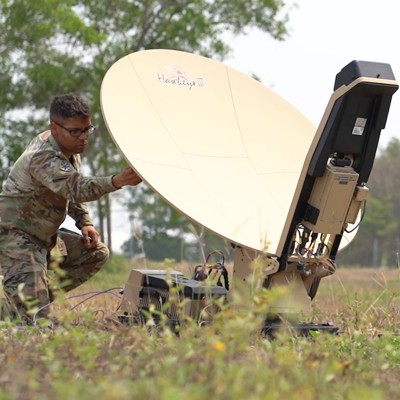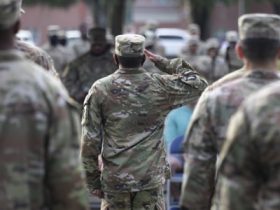After years of building bespoke networks to connect with individual allied and partner militaries, U.S. Indo-Pacific Command is preparing to bring nearly two dozen countries into a single network in 2025.
This INDOPACOM Mission Network, or IMN, is meant to replace the current unwieldy situation with a single seamless and secure platform that provides a common operating picture, file transfer, voice and chat tools. And while the IMN itself is meant for high-level information-sharing, it is intended to eventually enable new tactical networks as well.
“Most of our operations are not just joint, they are combined, they’re multilateral, and this network of alliances and partnerships are, in fact, our key strategic asymmetric advantage,” Adm. Sam Paparo, who leads the command, said last month at the AFCEA TechNet conference in Honolulu, Hawaii. Paparo said the IMN will make it “so that we’re operating off the same picture at all times, we’re able to pass mission orders at all times, so that we’re able to achieve unity of effort at all times.”
As INDOPACOM expanded its exercises with regional militaries over the years, it often tailored a new network for each new partner or ally, ultimately creating some 20 of these bespoke networks. This made adding partners to multilateral wargames increasingly complicated, said Brig. Gen. Mark Miles, who led the command’s Command, Control, Communications and Cyber Directorate until a few months ago.
“For example, if we’re doing an exercise with Japan and then at the last minute we include Australia, that’s two different networks. We have a network we use to share with Japan, and we have a network we use to share with Australia. And, to collaborate across those two networks involved manual data movement, so thumb drives or CDs, or sometimes people looking at two different monitors,” said Miles, who is now deputy commander of the U.S. Army Cyber Center of Excellence.
Over the past two years, Miles led the effort to create a network that could securely accommodate all, or at least most, of INDOPACOM’s partners.
In February, the IMN stood up with initial operating capacity for Keen Edge, a long-running U.S.-Japan exercise that this year included Australian forces for the first time. The network was subsequently approved for use by the Five Eyes, the intelligence alliance of the U.S., U.K., Australia, New Zealand, and Canada. IMN was also used in June’s Valiant Shield, a larger multinational wargame designed to boost interoperability. Over the summer, South Korea was added to the IMN. Next up, the Philippines.
“We’re currently participating in Exercise Bold Quest 24 as proof of concept for our Indo-Pacific Mission Network Tactical Data Center. And by 2025, in the summer, our mission network will reach full operational capability during Exercise Pacific Sentry,” Paparo said.
Once IMN gains approval by the National Security Agency, the admiral said, its zero trust architecture “will be operationalized with our allies and partners.”
By the end of next year, INDOPACOM aims to connect 23 nations with key applications like phone and video calls, chat tools, file sharing, email, and a common operational picture.
Miles said the IMN is built to accommodate other militaries’ varying technical abilities and security requirements, using on-premise and cloud-based solutions.
“There are limitations to what we can put in the cloud. So I would say it’s a hybrid. And I’ll also say that we built and designed and architected the network with the ability to move it to the cloud at some time in the future. So we did that by building everything containerized,” he said.
Paparo said the new network would help with one of his command’s top priorities: “counter-C5ISR and T,”—that is, “the ability to dazzle, deceive, destroy…at times of our choosing, [our] adversary’s ability to see and sense the battle space. And to do so while being interoperable with our allies and partners.”
Army’s tactical network
IMN’s use focuses on a strategic or perhaps operational, level. But the network’s architecture also makes it possible to link with platforms—dubbed “tactical mission partner environments”—that connect military units at lower echelons.
The first of these will likely be deployed by U.S. Army Pacific Forces, which has been testing out preliminary equipment sets in various coalition exercises.
“It’s iterative, and it’s evolving,” Gen. Charles Flynn, then the commander of U.S. Army Pacific, told reporters in May. ”Because the partner plays a role here, we have to do continual assessments of that architecture to make sure that we don’t expose them or us the challenges with that communications network.”
The effort is being led by I Corps, the Army Pacific formation based at Joint Base Lewis-McChord, Washington. The corps is currently in Japan, setting up for a mega wargame that will test the MPEs capabilities.
“We are going to be the first tactical mission partner environment network that gets connected to the INDOPACOM Mission Network. That’s our goal,” said Col. Rett Burroughs, I Corps’ chief information officer. “All the way down and put it into vehicles that move and put it on the backs of soldiers that walk.”
Burroughs said the corps has been installing networking gear in various partner nations over the past year.
“We actually have our tactical server infrastructure in place all across the Pacific. We can now talk on our mission partner environment with the Australian 1st Division in Brisbane. We have our connection in Thailand and the Philippines,” he said.
But the networking software is coming more slowly. Over the past year, I Corps created and tested a tactical network between the U.S., Japan, and Australia with a simple goal: enable an Australian service member to send an email to her Japanese counterparts. There’s no data-sharing policy between the three nations, which limits what can be shared between their respective networks.
“If you, from the Australian side, were going to send me, a Japanese officer, an email, you can’t send an attachment. We would actually take that attachment and we would just make it disappear. But the body of the text would go through,” Burroughs said.
I Corps aims to test and refine the new system in December.
“We’re throwing our warfighter exercise that [U.S. Army Forces Command] requires us to do every two years on top of an [U.S. Army Pacific] exercise that we do every year. So we’re going to mash two exercises into one…it’s going to be a pretty chaotic event for us communicators, to say the least, because it’s never been done before,” Burroughs said. “We’re going to refine them to make them simpler, more effective, and just a little more seamless to the operator so they don’t have to take as many steps,” like being able to find files easier.
The goal is to inform the Army, Indo-Pacific Command, and the Joint Staff on “what we know works in the Pacific” using real-world test cases at scale to form requirements.
“Technologically, there’s nothing that we can’t do,” Burroughs said. “Everything that we see in science and science fiction, we can do it. But policy has to dictate what we’re actually allowed to do. So those trilat agreements…military-level discussions, those are happening and those have to happen in order for us to modernize.”
Read the full article here







Leave a Reply